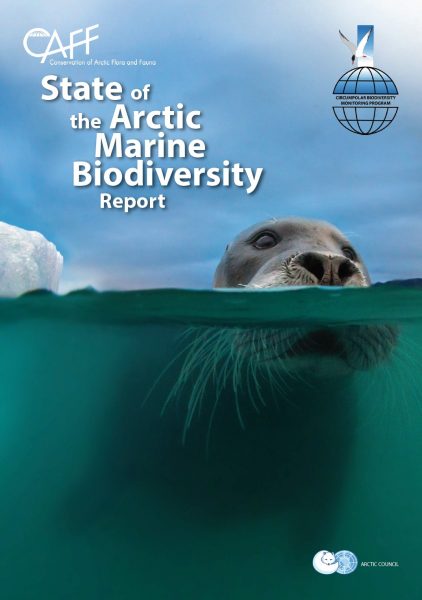UAF scientists offer ideas on tracking Arctic biodiversity
May 11, 2017
Lauren Frisch
907-474-5350
 Changing food sources, shrinking ice, increasing diseases and invading southern species
are taking their toll on Arctic marine animals. A new report from the Conservation
of Arctic Flora and Fauna, the Arctic Council's biodiversity working group, suggests
ways to monitor such changes across the Arctic.
Changing food sources, shrinking ice, increasing diseases and invading southern species
are taking their toll on Arctic marine animals. A new report from the Conservation
of Arctic Flora and Fauna, the Arctic Council's biodiversity working group, suggests
ways to monitor such changes across the Arctic.The 60 international experts in CAFF’s Circumpolar Biodiversity Monitoring Network included Russ Hopcroft, Katrin Iken and Eric Collins from the University of Alaska Fairbanks College of Fisheries and Ocean Sciences.
The experts compiled the State of the Arctic Marine Biodiversity Report, which identifies trends in key marine species and highlights gaps in monitoring of several ecosystem components: sea-ice organisms, plankton, sea-bottom life, marine fishes, seabirds and marine mammals. Changes in these areas indicate changes in the overall marine environment.
Expert committees sifted through existing data on Arctic marine species, including seasonality, abundance, distribution and diversity. They discussed similarities and differences in international approaches to monitoring key species and used this information to recommend future monitoring.
The benthic team focused on bottom-dwelling animals, including sea stars and clams. Iken noted that some countries, such as Norway, Iceland and Greenland, operate formal benthic monitoring programs. Others, such as the U.S., Russia and Canada, tend to gather information project-by-project. The differences posed challenges for the benthic analysis, Iken said.
The benthic experts worked to determine where their monitoring approaches had common ground. Small variations in gear or methods, like differences in the mesh size of collection nets, can affect species measurements and research results. Even the naming of species is not always consistent across countries.
“If you’re looking to determine how a species’ range is changing over time, knowing what everyone calls that species is critical,” Iken explained. “We understand that we’ll never all do exactly the same thing, but this process has helped us evaluate when we can confidently compare our approaches, and when we need to be careful before we make any kind of comparisons.”
The plankton team said a central repository of plankton data sets would help in comparing methods and results. A lack of long-term data limits understanding of plankton distribution and community composition, they found.
“It is through repeated and ongoing sampling that we can begin to understand how species are changing,” Hopcroft said. “Long-term monitoring efforts can also reveal how efficient our methodology is in actually detecting plankton shifts.”
As in benthic analysis, countries have developed specialized regional approaches to monitoring plankton. The experts evaluated these to learn how processes can be improved.
“Plankton tend to rapidly reflect changes in ecosystem physics, but the challenge remains having enough data to see cycles or changes through the noise created by year-to-year variability within each region,” said Hopcroft. “Nonetheless, 70 years of observations in the Chukchi Sea suggest long-term increases in plankton productivity associated with decreasing ice cover and increasing temperatures.”
The sea ice biota team focused on microscopic bacteria, algae, and animals living in sea ice. This proved to be challenging, Collins explained, as researchers are still working to establish a baseline understanding of what kind of microbes live in the ice.
“The big takeaway for our team was that there’s essentially no monitoring for microbes that’s ongoing in the Arctic,” Collins said. “This is partially because we don’t have a solid understanding of the species in the region. Knowing what to expect when we go to a particular region to study is important, before we can branch into the monitoring realm."
The sea ice team focused its discussion on strategies for developing sea ice microbe programs in existing research projects and exploring new ways to collaborate and standardize monitoring processes.
Refer to the Circumpolar Biodiversity Monitoring Program’s Marine Expert Networks for more information. A link to the CAFF report is available at https://www.arcticbiodiversity.is/press-sambr.


